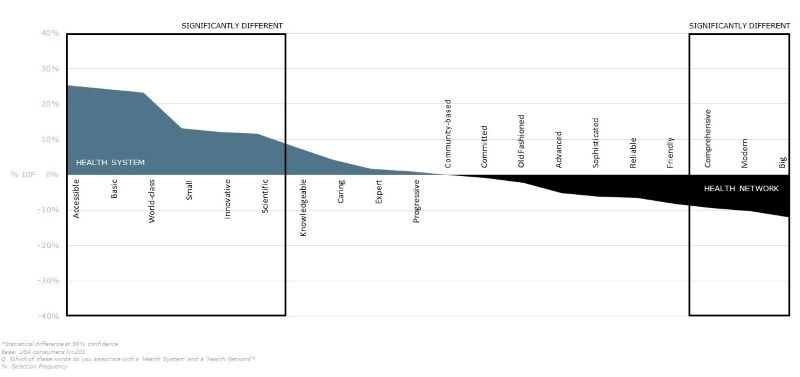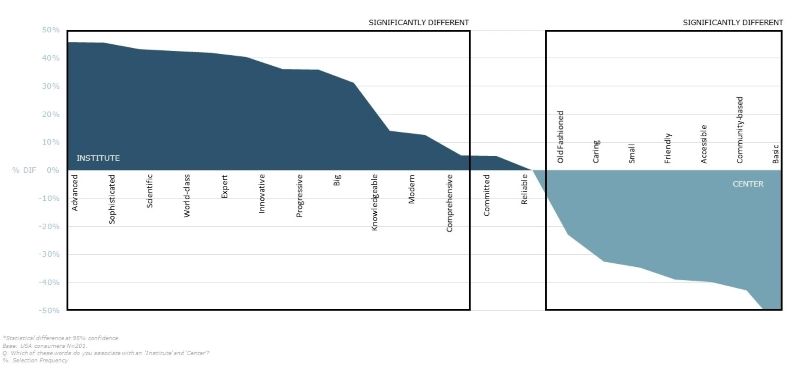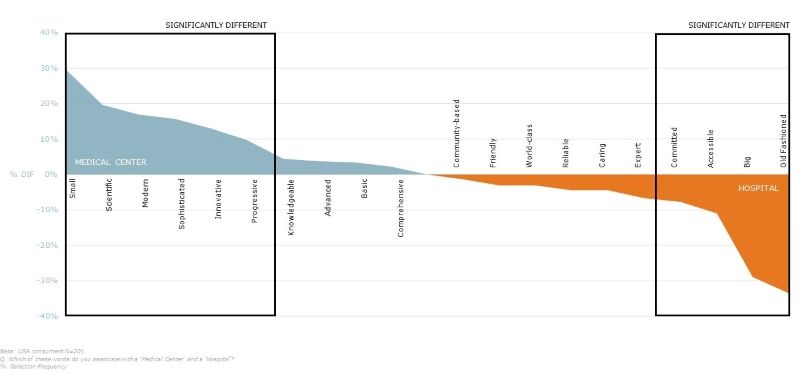Breaking Through the Naming Noise

Three Simple Steps to Inform Health Care Nomenclature Strategy
For nearly 50-years Monigle has worked with a variety of leading health care brands across the country. Almost every engagement at some points addresses the sticky issue of nomenclature strategy. Simply put, what do you call the entities, locations, services, and specialties that define the ecosystem of care that millions of consumers turn to every day? Carefully crafting a scalable nomenclature strategy requires defining and connecting three key elements:
-
- What’s expected = perception
- What’s provided = offering
- What’s promised = brand
Most organizations spend a lot of time focusing on the offering – an inside out view limited to the services provided. At its worst, these critical nomenclature decisions are addressed one-off and won by the loudest voice in the room, often with a subjective bias. However, without a full understanding of consumer perceptions, you can inadvertently create confusion and dilute the equity of your brand with something as simple as how you reference your newest location.
Learn More: 3 Strategies for building consumer trust (and what to do if you’ve lost it)
This critical outside-in view of the opportunity begins with the inherent preconceptions of consumers. Absence of this perspective fuels the nomenclature paradox – a simple word can unintentionally work against what you are trying to say. Implicit associations are attached to almost every word. These perceptions are seeded in the psyche of every person based on past experiences and established conventions that are formed long before anyone walks through your doors.
Let’s start by bringing this paradox a little closer to the world of health care. Some health care providers refer to their collective organization as a “system”. Others refer to their footprint as a “network”, which is further complicated with the existence of secondary networks – everything from clinically integrated networks (CIN) to in-home care networks.
The seemingly simple choice of what to call a “system” and what to call a “network” has implications in terms of connecting with the patients you are looking to serve. Finding clarity lies in answering a simple question:
What is the perceived difference between networks and systems?
While qualifying the same word in different ways is perfectly fine to create distinction across the different types of networks, for example, it is important to understand existing consumer perceptions when it comes to the options you have. We set out to better understand the perceived difference between “system” and “network” through a quantitative national study with health care consumers.
Here is what we learned:
-
- Health systems and Health networks are largely synonymous with consumers and can be easily interchanged
- Health networks better convey scale and complexity. They are also seen as more modern
- Health systems feel slightly more accessible, scientific and world-class than health networks

These perceptions provide clues to being more intentional about your nomenclature strategy and the words you use. Especially given that research shows consumers see “network” and “system” being easily interchanged, making the choice requires digging deeper. The research also shows that “networks” are seen as more modern and “systems” feel slightly more scientific to consumers. Determining the right strategy for your organization depends on service delivery and brand promise:
-
- If the entity you are naming houses cutting-edge services, you would want to choose the word that is perceived as more modern – “network”
- In describing that entity, you would want to use the promise of your brand to illuminate what the perception of modernity means in terms of who you are and what you stand for as an organization
Learn More: Leading with Brand: 3 ways brand and marketing can create more human health care experiences
Ultimately, your organization is armed to explain the difference between what you refer to as a system, a network, and even different types of networks within your care ecosystem.
Three key steps of nomenclature strategy
Following are three key steps to ensuring your nomenclature strategy is informed by these perceptions and not left to the tendency of subjective, one-off decisions:
Do you need to capitalize or counter existing customer perceptions? Changing existing perceptions can be time-consuming and costly.
Do the services you offer match the expectations associated with the perception? The services you provide will inevitably lean into, or away from, the existing perception.
How can the promise of your brand be used to capitalize on the intersection of perception and service delivery? Your nomenclature strategy opens the door to tell your unique brand-informed story. |
Applying the three steps above will ensure success for just about any naming challenge your organization is faced with.
Learn More: Meet the health care disruptors coming for your consumers
To help jumpstart this process, following are the perceptual clues (Step #1 above) our research uncovered for three more of the most common nomenclature challenges, in addition to “network” versus “system”, health care organizations face:
What is the perceived difference between institutes and centers?
- Institutes and centers are seen as very different in meaning with Institutes owning more positive associations overall
- Institutes are seen as more sophisticated, scientific, world-class, expert and at the forefront of innovation
- Centers are seen as providing basic, community-based care that is accessible and friendly
- However, centers are also more associated with preventative care and wellness than institutes

What is the perceived difference between medical centers and hospitals?
- The biggest difference between medical centers and hospitals is that medical centers are perceived to be small and modern whereas hospitals are perceived to be big and old fashioned
- Hospitals are also more associated with being committed, accessible and an integral part of communities
- In contrast, Medical centers better convey scientific, sophisticated, innovative, progressive, preventative care and wellness perceptions

Nomenclature, specifically with complex and changing health care environments, can be difficult to understand and get out of an “insider baseball” mindset. We hope that our outside-in research of health care consumers on this topic can help provide some clarity to health care brand leaders and begin to help us understand consumer perceptions as we navigate this space.
Want to learn more or chat with us about these learnings? Please reach out to us and continue the conversation.


